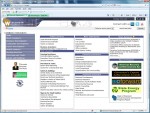Revisions/extensions (6:45 pm 9/9/2009) – With a tip of the hat to Owen, we have some more-daunting US-specific numbers from the AP, as well as a Idiotic Quote of the Day nominee. Given that, and a review of the actual report, I’ve decided to ReWrite™ the entire post. The original post is archived and struck through below.
The Congressional Oversight Panel, in charge of keeping track of money expended by TARP, issued a report asserting that most of the $14.3 billion spent on UAW Motors and its predecessor, Chrysler LLC, the $49.9 billion spent on Government Motors and its predecessor, General Motors Corporation, and $16.9 billion spent on other elements of the automotive industry will never be repaid. I’m shocked, SHOCKED to find this out.
Let’s review what happened to the money that went out the Treasury door to the two big auto companies:
- Chrysler LLC (now known as Old Carco LLC)/Chrysler Financial/UAW Motors:
- Originally-loaned-and-used amounts ($14.31 billion total; does not include credit facilities not used):
- $4 billion went to Chrysler on 1/2/2009
- $1.5 billion went to Chrysler Financial on 1/16/2009
- $280 million went to Chrysler for warranty obligations on 4/29/2009
- $1.89 billion in used Debtor-In-Possession financing went to Chrysler in May
- $6.64 billion went to UAW Motors in the form of senior secured debt when it emerged from bankruptcy
- Repaid amounts ($1.78 billion total):
- $1.5 billion (the entirety) of the Chrysler Financial loan repaid
- $280 million (the entirety) of the Chrysler warranty loan repaid
- Remaining obligations ($12.53 billion):
- $7.14 billion owed by UAW Motors in the form of senior secured debt (includes $500 million of the original $4 billion loan assumed by the new company)
- $5.39 billion owed by Old Carco LLC in the form of unsecured debt, not expected to be repaid as the assets of the old company are expected to be exhausted before secured debtors are paid in full
- Assets owned by the US Treasury:
- 9.85% of UAW Motors common stock (to be reduced to as low as 8% if Fiat meets up to alll three of its goals to raise its stake from 20% to 35%)
- A claim of the greater of 40% of Chrysler Financial’s equity value or
$1.135 $1.375 billion, to be applied toward repayment of the original $4 billion loan
- General Motors Corporation (now known as Motors Liquidation Company)/Government Motors:
- Originally-loaned-and-used amounts ($49.89 billion total; does not include a $880 million loan to GM made on 12/29/2008 in exchange for GMAC equity):
- $13.4 billion went to General Motors on 12/31/2008
- $2 billion went to General Motors on 4/22/2009
- $4 billion went to General Motors on 5/20/2009
- $360 million went to General Motors for warranty obligations on 5/27/2009
- $30.1 billion in Debtor-In-Possession financing went to General Motors in June and July
- Repaid amounts ($360 million total):
- $360 million of the DIP financing repaid (the report scores it as a Government Motors debt repaid, though it was repaid before Government Motors assumed its portion of the DIP debt)
- Obligations that went toward buying 61% of Government Motors common stock ($39.7 billion total) and $2.1 billion of Government Motors prefered stock (all toward the common stock unless otherwise noted):
- $13.4 billion (the entirety) of the 12/31/2008 loan
- $2 billion (the entirety) of the 4/22/2009 loan
- $4 billion (the entirety) of the 5/20/2009 loan
- $360 million (the entirety) of the 5/27/2009 warranty loan
- $19.94 billion of the DIP financing for common stock
- $2.1 billion of the DIP financing for prefered stock
- Remaining obligations ($7.7 billion):
- $6.71 billion of former DIP financing owed by Government Motors in senior secured debt
- $990 million of former DIP financing owed by Motors Liquidation Company in a Wind-Down Facility, which is secured debt
- Assets owned by the US Treasury:
- 61% of Government Motors common stock
- $2.1 billion of Government Motors prefered stock
The CNN story referenced in the original post notes that the $5.4 billion given to UAW Motors is as good as gone. I haven’t seen any plans on how the US and Canadian governments plan to divest themselves of their stakes in the company, but I doubt they’ll get more than $1.1 billion for the remains of Chrysler Financial or $4.3 billion for an 8% stake in UAW Motors.
Meanwhile, The Wall Street Journal reported in July that Government Motors plans on having an IPO sometime in 2010, with full divesture in 2018. Does anybody believe they’ll get $40 billion for 61% of GM or $2.7 billion for the non-voting prefered stock?
That does not address the possibility that UAW Motors and Government Motors will either dip back into the public trough or re-enter bankruptcy. In that case, even the secured debt might not be paid back in full.
That brings me to the Idiotic Quote of the Day. Let’s have the AP deliver it:
“I think they drove a very hard bargain,” said Elizabeth Warren, the panel’s chairwoman and a law professor at Harvard University, referring to the Obama administration’s Treasury Department. “But it may not be enough.”
Hard bargain? For full repayment of the TARP moneys, the Congressional Oversight panel estimates Government Motors would need to reach a total market capitalization of $67.7 billion and UAW Motors would need to reach a total market capitalization of $57.5 billion. That compares very unfavorably to General Motors’ peak market capitalization of $57.2 billion in 2000 (not adjusted for inflation). Further, if memory serves, Chrysler was never worth more than about $25 billion.
Shoebox pointed to a CNN story that says that much of the $60 billion in tax dollars provided to both UAW Motors (nee Chrysler) and Government Motors (nee General Motors) will not be paid back. I’m shocked, SHOCKED to find this out.
Let’s review what happened to the money that went out the door:
– Something north of $13.4 billion from both the US and Canadian governments went to UAW Motors and its predecessor, Chrysler LLC, with $6 billion of that converted to senior secured debt held by the new UAW Motors, and an additional $2 billion spent to buy the assets of Chrysler LLC in exchange for 12.31% of UAW Motors (to be reduced to as low as 10% if Fiat meets certain goals). The remaining $5.4 billion, all unsecured debt, remained with Old Carco LLC, which will almost certainly run out of money and assets before it completes paying the $5 billion it owes its secured debtors.
– Somewhere around $50 billion went to Government Motors and its predecessor, General Motors Corporation, with $7.07 billion in Debtor-In-Possession financing converted to senior secured debt held by the new Government Motors and an additional $1.18 billion in DIP financing converted into a Wind Down Facility loan held by Motors Liquidation Company and given senior secured debt status. The remaining $42 billion was forgiven in exchange for the governments’ nearly-73% share in Government Motors.
The CNN story notes that the $5.4 billion given to UAW Motors is as good as gone. I haven’t seen any plans on how the US and Canadian governments plan to divest themselves of their stakes in the company, but I doubt they’ll get $2 billion for less than 10% of the company.
Meanwhile, The Wall Street Journal reported in July that Government Motors plans on having an IPO sometime in 2010, with full divesture in 2018. Does anybody believe they’ll get almost $42 billion for 73% of GM?
That does not address the possibility that UAW Motors and Government Motors will either dip back into the public trough or re-enter bankruptcy. In that case, even the secured debt might not be paid back in full.


